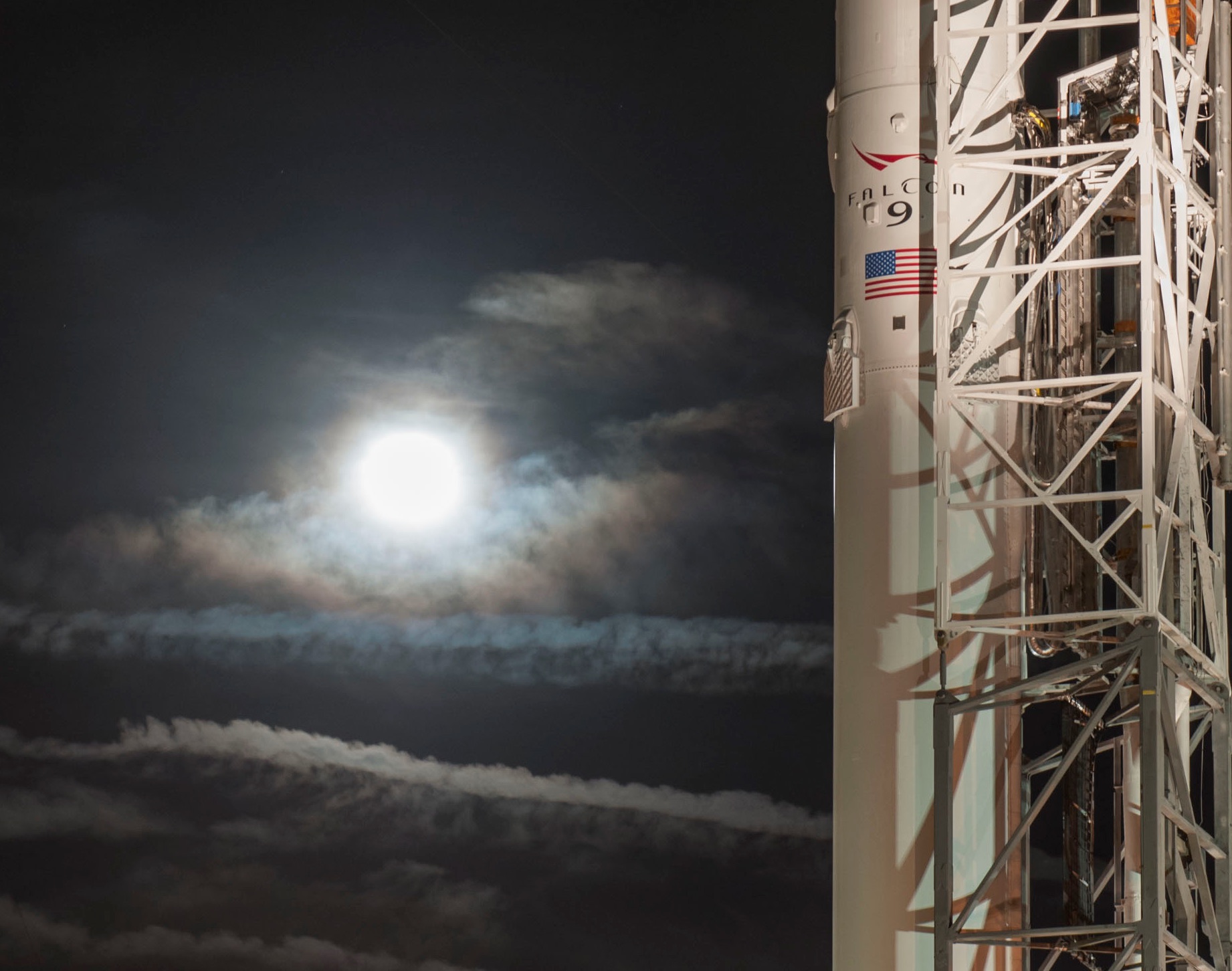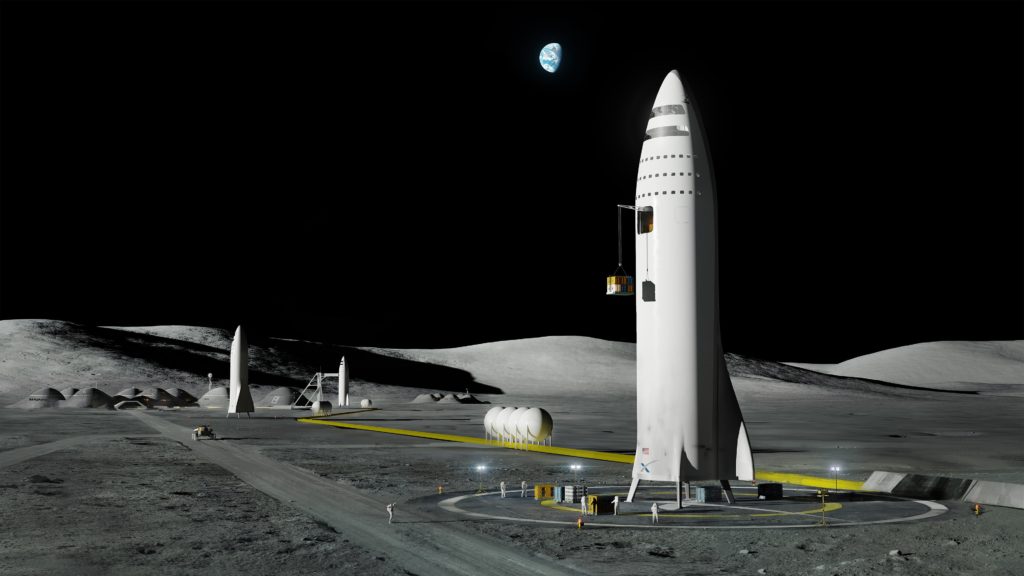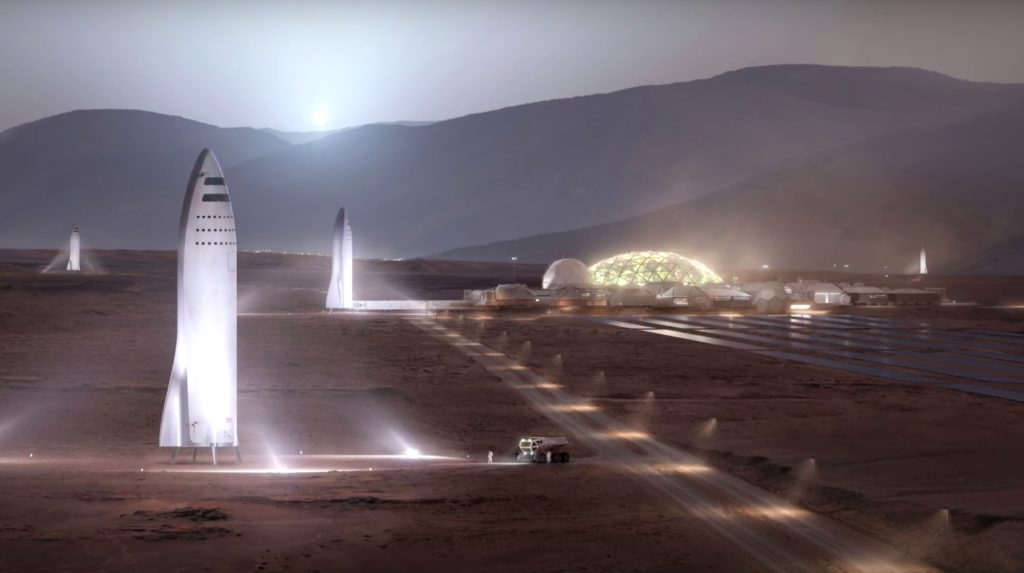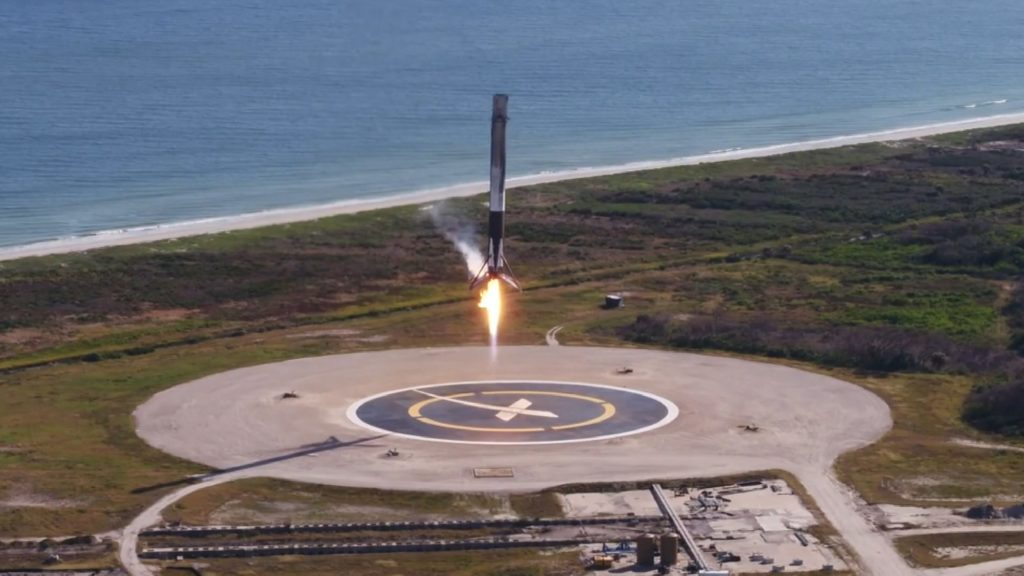

News
SpaceX talks Moon mission as strategic stepping stone for Mars colony
Josh Brost, Senior Director of SpaceX’s Government Business Development was in attendance at a civil spaceflight conference in Washington D.C. yesterday, January 18, and provided a number of interesting details about SpaceX’s upcoming activities in 2018. Perhaps most intriguingly, he reiterated SpaceX’s interest in enabling exploration of the Moon and Mars, while also clarifying that the upcoming Falcon 9 upgrade will be the last major change to the vehicle for the indefinite future.
Although the audience may have been more focused on SpaceX’s potential lunar prospects, Brost provided a vision similar to CEO Elon Musk’s common-knowledge goal of Martian (and interplanetary) colonization. This lunar focus was in part evidenced by a pointed question from an audience member that triggered Brost’s subsequent suggestion that the Moon could be a more logical starting place for the company as it ramps up its deep space efforts and gradually slips beyond Earth orbit. This strategic and calculated extension of the aspirations of the launch company’s famous founder is a rational attempt to position SpaceX in ways that allow the company to derive as much value as possible from the US government’s recently revived interest in returning the US and its astronauts to the Moon.
- SpaceX’s 2017 BFS (now Starship) delivers cargo to a large lunar base. (SpaceX)
- Starship and a Martian city, circa 2017. (SpaceX)
To a large extent, his comments mesh with the vision Elon Musk reiterated at 2017’s September IAC.
SpaceX’s next-generation heavy-lift rocket and spaceship (BFR and BFS) are being designed to carry 150 metric tons into low Earth orbit while still recovering both the first and second stages, and will be purpose-built for rapid and complete reusability. BFR and BFS are also being intentionally designed to be relatively destination-agnostic. In other words, BFS will be capable of transporting cargo and eventually crew to a number of destinations in the solar system, be it the Moon, Mars, or beyond. The outer planets are almost certainly off limits for crew due to the sheer length of any journey beyond the orbit of Mars, but BFR, as it was discussed last year, would be capable of transporting unprecedented amounts of cargo almost anywhere in the solar system. Reusability is, of course, paramount to SpaceX’s operational intent with BFR/BFS; unless a very lucrative offer is made, it is highly unlikely that SpaceX will even consider expendable missions, thus partially limiting what the next-gen vehicle will be capable of.
Still, it will be an incredibly capable rocket even with full reusability. Add in the potential promise of mature in-situ resource utilization (ISRU), more simply the production of methane and oxygen propellant at the destination, and it will open a hundred entirely new worlds to serious scientific, exploratory, and economic prospecting throughout the solar system.
What’s next?
The question, then, is “when?” While Brost did not specifically provide any sort of timeline for BFR, aside from a brief statement on its readiness in “a few years,” he did describe in some detail the imminent end of serious Falcon 9 upgrades. A continual stream of upgrades and modifications has been one of the only real constants with SpaceX’s Falcon 9 rocket: the original Falcon 9 is in almost every respect a completely different rocket when compared to the Falcon 9 Full Thrust (FT/1.2) of the present. However, one final leap is expected for Falcon 9, this time almost exclusively intended to improve the vehicle’s reliability and reusability as SpaceX rapidly approaches its first flights of Crew Dragon and dreams of rapid and repeated booster reuse.
While it was a small detail in an obscure sentence of one of several hour-long discussions, Brost specifically stated this:
Brost: with Block 5, goal it to lock down the design and fly the vehicle at very high flight rates. Innovation will focus on designing and testing BFR.
— Jeff Foust (@jeff_foust) January 18, 2018
This is arguably the most exciting tidbit provided to us by SpaceX. While it was undeniably vague and rather less than crystal-clear, it can be interpreted as something like this: once Block 5 has been introduced and begun to fly and refly both regularly and successfully, the vast majority of SpaceX’s launch vehicle development expertise will begin to focus intensely on the development and testing of BFR and BFS.
Statements from just last week made by SpaceX President Gwynne Shotwell strengthen this intuitive leap considerably, because BFR and BFS are liable to require a considerable amount of attention as they proceed through design maturation and eventually begin physical hardware testing in Texas.
Shotwell’s comments implied that SpaceX’s Boca Chica launch facilities, currently under construction, would be ready to support “vehicle tests” as early as late 2018/early 2019. Comments from earlier in 2017 indicate that SpaceX (and Shotwell) perceive Boca Chica as a near-perfect location for BFR launches (and thus BFR testing, as well). Finally, Brost’s implication that SpaceX’s exceptional team of brilliant and innovative launch vehicle engineers would be refocused on BFR soon after Block 5 was stable also meshes with this rough timeline. If Falcon 9 Block 5 does indeed debut within the “next few months” as Brost stated, it will have likely reached some level of design and operational maturity by the end of 2018, assuming SpaceX’s expected launch cadence.
- SpaceX’s Falcon 9 ahead of the launch of Zuma. (Tom Cross/Teslarati)
- A Falcon 9 lifts off from LC-40 carrying the highly secretive Zuma spacecraft. Hispasat 30W will launch from the same pad in just a few days. (Tom Cross)
- Falcon 9 1035 conducts its second landing after successfully launching CRS-13 on December 15. Improved reusability will be a huge focus of SpaceX in 2018. (NASA)
As of right now, SpaceX is already looking at a very busy February, and currently has as many as three commercial launches scheduled within a period of maybe three weeks (GovSat-1, PAZ, and Hispasat), maybe even four if Falcon Heavy completes its first static fire later this weekend. Musk estimated that SpaceX would complete 30 missions in 2018, and a cadence anywhere near three launches per month (let alone four) would easily push SpaceX past that goal and provide the company dozens of opportunities to test, launch, recover, and relaunch their new Block 5 version of Falcon 9. As such, while BFR is probably not going to reach fully integrated hardware development or testing in 2018, it is certainly a distinct possibility, and 2019 is far more promising for the company’s interplanetary aspirations.
For now, SpaceX’s 2018 focus is quite explicitly centered on ensuring the reliability of its Crew Dragon – set to debut NET August 2018 – and Falcon 9 as it strives to complete the development of both vehicles. Up next on the company’s busy schedule is another attempt at Falcon Heavy’s inaugural static fire on Saturday afternoon, as well as the flight-proven launch of GovSat-1/SES-16, currently NET January 30.
Follow along live as launch photographer Tom Cross and I cover these exciting proceedings live from both coasts.
Teslarati – Instagram – Twitter
Tom Cross – Instagram
Eric Ralph – Twitter
News
Tesla begins Robotaxi certification push in Arizona: report
Tesla seems serious about expanding its Robotaxi service to several states in the coming months.

Tesla has initiated discussions with Arizona transportation regulators to certify its driverless Robotaxi service in the state, as per a recent report from Bloomberg News. The move follows Tesla’s launch of its Robotaxi pilot program in Austin, Texas, as well as CEO Elon Musk’s recent comments about the service’s expansion in the Bay Area.
The Arizona Department of Transportation confirmed to Bloomberg that Tesla has reached out to begin the certification process for autonomous ride-sharing operations in the state. While details remain limited, the outreach suggests that Tesla is serious about expanding its driverless Robotaxi service to several territories in the coming months.
The Arizona development comes as Tesla prepares to expand its service area in Austin this weekend, as per CEO Elon Musk in a post on X. Musk also stated that Tesla is targeting the San Francisco Bay Area as its next major market, with a potential launch “in a month or two,” pending regulatory approvals.
Tesla first launched its autonomous ride-hailing program on June 22 in Austin with a small fleet of Model Y vehicles, accompanied by a Tesla employee in the passenger seat to monitor safety. While still classified as a test, Musk has said the program will expand to about 1,000 vehicles in the coming months. Tesla will later upgrade its Robotaxi fleet with the Cyercab, a two-seater that is designed without a steering wheel.
Sightings of Cybercab castings around the Giga Texas complex suggests that Tesla may be ramping the initial trial production of the self-driving two-seater. Tesla, for its part, has noted in the past that volume production of the Cybercab is expected to start sometime next year.
In California, Tesla has already applied for a transportation charter-party carrier permit from the state’s Public Utilities Commission. The company is reportedly taking a phased approach to operating in California, with the Robotaxi service starting with pre-arranged rides for employees in vehicles with safety drivers.
News
Tesla sets November 6 date for 2025 Annual Shareholder Meeting
The automaker announced the date on Thursday in a Form 8-K.

Tesla has scheduled its 2025 annual shareholder meeting for November 6, addressing investor concerns that the company was nearing a legal deadline to hold the event.
The automaker announced the date on Thursday in a Form 8-K submitted to the United States Securities and Exchange Commission (SEC). The company also listed a new proposal submission deadline of July 31 for items to be included in the proxy statement.
Tesla’s announcement followed calls from a group of 27 shareholders, including the leaders of large public pension funds, which urged Tesla’s board to formally set the meeting date, as noted in a report from The Wall Street Journal.
The group noted that under Texas law, where Tesla is now incorporated, companies must hold annual meetings within 13 months of the last one if requested by shareholders. Tesla’s previous annual shareholder meeting was held on June 13, 2024, which placed the July 13 deadline in focus.
Tesla originally stated in its 2024 annual report that it would file its proxy statement by the end of April. However, an amended filing on April 30 indicated that the Board of Directors had not yet finalized a meeting date, at least at the time.
The April filing also confirmed that Tesla’s board had formed a special committee to evaluate certain matters related to CEO Elon Musk’s compensation plan. Musk’s CEO performance award remains at the center of a lengthy legal dispute in Delaware, Tesla’s former state of incorporation.
Due to the aftermath of Musk’s legal dispute about his compensation plan in Delaware, he has not been paid for his work at Tesla for several years. Musk, for his part, has noted that he is more concerned about his voting stake in Tesla than his actual salary.
At last year’s annual meeting, TSLA shareholders voted to reapprove Elon Musk’s compensation plan and ratified Tesla’s decision to relocate its legal domicile from Delaware to Texas.
Elon Musk
Grok coming to Tesla vehicles next week “at the latest:” Elon Musk
Grok’s rollout to Tesla vehicles is expected to begin next week at the latest.

Elon Musk announced on Thursday that Grok, the large language model developed by his startup xAI, will soon be available in Tesla vehicles. Grok’s rollout to Tesla vehicles is expected to begin next week at the latest, further deepening the ties between the two Elon Musk-led companies.
Tesla–xAI synergy
Musk confirmed the news on X shortly after livestreaming the release of Grok 4, xAI’s latest large language model. “Grok is coming to Tesla vehicles very soon. Next week at the latest,” Musk wrote in a post on social media platform X.
During the livestream, Musk and several members of the xAI team highlighted several upgrades to Grok 4’s voice capabilities and performance metrics, positioning the LLM as competitive with top-tier models from OpenAI and Google.
The in-vehicle integration of Grok marks a new chapter in Tesla’s AI development. While Tesla has long relied on in-house systems for autonomous driving and energy optimization, Grok’s integration would introduce conversational AI directly into its vehicles’ user experience. This integration could potentially improve customer interaction inside Tesla vehicles.
xAI and Tesla’s collaborative footprint
Grok’s upcoming rollout to Tesla vehicles adds to a growing business relationship between Tesla and xAI. Earlier this year, Tesla disclosed that it generated $198.3 million in revenue from commercial, consulting, and support agreements with xAI, as noted in a report from Bloomberg News. A large portion of that amount, however, came from the sale of Megapack energy storage systems to the artificial intelligence startup.
In July 2023, Musk polled X users about whether Tesla should invest $5 billion in xAI. While no formal investment has been made so far, 68% of poll participants voted yes, and Musk has since stated that the idea would be discussed with Tesla’s board.
-

 Elon Musk1 week ago
Elon Musk1 week agoTesla investors will be shocked by Jim Cramer’s latest assessment
-

 Elon Musk19 hours ago
Elon Musk19 hours agoxAI launches Grok 4 with new $300/month SuperGrok Heavy subscription
-

 Elon Musk3 days ago
Elon Musk3 days agoElon Musk confirms Grok 4 launch on July 9 with livestream event
-

 News7 days ago
News7 days agoTesla Model 3 ranks as the safest new car in Europe for 2025, per Euro NCAP tests
-

 Elon Musk2 weeks ago
Elon Musk2 weeks agoA Tesla just delivered itself to a customer autonomously, Elon Musk confirms
-

 Elon Musk1 week ago
Elon Musk1 week agoxAI’s Memphis data center receives air permit despite community criticism
-

 Elon Musk2 weeks ago
Elon Musk2 weeks agoTesla’s Omead Afshar, known as Elon Musk’s right-hand man, leaves company: reports
-

 News2 weeks ago
News2 weeks agoXiaomi CEO congratulates Tesla on first FSD delivery: “We have to continue learning!”



















